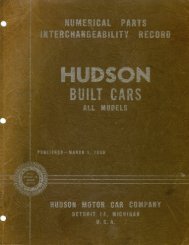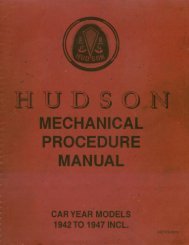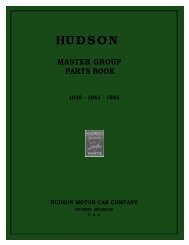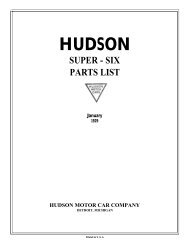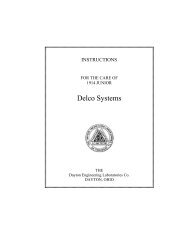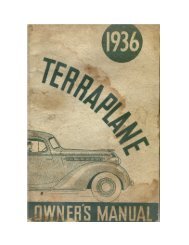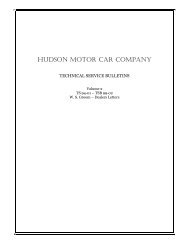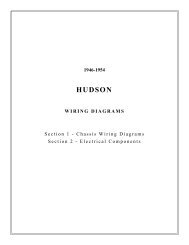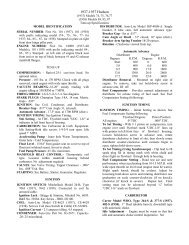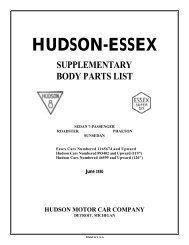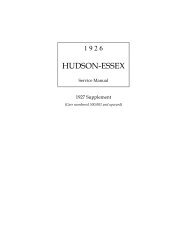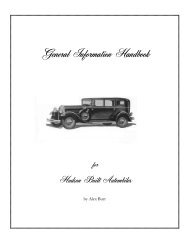1948-1952 Shop Service Manual - - Hudson-Essex-Terraplane Club
1948-1952 Shop Service Manual - - Hudson-Essex-Terraplane Club
1948-1952 Shop Service Manual - - Hudson-Essex-Terraplane Club
You also want an ePaper? Increase the reach of your titles
YUMPU automatically turns print PDFs into web optimized ePapers that Google loves.
CLUTCH 7 - 7<br />
ENGAGING SPRINGS<br />
If clutch pressure plate shows signs of overheating, it is<br />
likely that the engaging springs will require replacement.<br />
Inner and outer springs should be checked for tension at<br />
each overhaul using the Valve Spring Tester Tool KMO-<br />
607 and checking against the tension data as follows:<br />
Inner all © 1-5/8" -- 75 to 85 lbs.<br />
Outer all © 1-5/8" -- 130 to 140 lbs.<br />
THROWOUT FINGERS<br />
Visually check the fingers for wear and uneven surfaces<br />
at the points where the fingers contact the throwout bearing<br />
and retainers, also check the retaining pin bores. Replace<br />
fingers that show noticeable wear.<br />
RETAINERS AND WASHERS<br />
Check retainers for wear at slot where they contact the<br />
lobed surface of the fingers. The bearing surface on the<br />
retainers is practically a line contact. If bearing area of<br />
retainer is grooved deeper than .005" replace the retainer. If,<br />
however, there is only one such groove, the retainer may be<br />
safely continued in service by rotating it 180 degrees from<br />
former position when it is being Installed. Changing the<br />
retainer position by half a turn will bring unworn portion<br />
into contact with finger fulcrum lobe.<br />
NOTE: The plain copper washers interposed between<br />
retainers and cover function as oil seals. Top and bottom<br />
faces of these washers must be flat and free of scores,<br />
otherwise they should be replaced.<br />
CLUTCH COVER<br />
Inner surface of cover must be flat and free from scores<br />
adjacent to the holes for the finger retainers. Cover must be<br />
flat within .005" when front face is checked on a surface<br />
plate.<br />
Distance from front face of cover where it contacts the<br />
flywheel gasket, to points on front wall of cover where<br />
retainer sealing washers fit (B) Figure 6, should not be less<br />
than 2.350" and not more than 2.370" measured 1/8" from<br />
edge of each of the 3-finger retainer holes.<br />
Variation in distance at any of, the 3 holes should not<br />
exceed .008". Covers that are not within these limits should<br />
be replaced unless equipment and skill is available for doing<br />
an accurate job of straightening.<br />
Cover hub bore (C) against which the throwout collar oil<br />
seal contacts, must be smooth and free from nicks and burrs.<br />
If cover hub bore (C) shows considerable wear and<br />
scoring, it is an almost certain indication of misalignment.<br />
Whenever this condition is encountered, b e sure to thoroughly<br />
check the engine rear support plate, flywheel and<br />
clutch bell housing, for shaft concentricity and face alignment<br />
in both planes.<br />
THROWOUT BEARING AND SEALS<br />
In the removal of clutch from engine, the throw out<br />
bearing (13), Figure 1, grease retainer (17) and clutch oil seal<br />
(14) will be removed as a single unit with the collar (12).<br />
Leather element of seal must be free of glaze and cuts or<br />
cracks and must be firmly attached to the stamped steel<br />
element. Leather must not rotate in relation to the stamping<br />
and the seal assembly must be stationary on the clutch<br />
collar. Check to see that coil spring is intact and not loose.<br />
Replacement of the oil seal necessitates removal of the<br />
throwout bearing from the clutch collar. Use care when<br />
pressing new seal onto collar, apply a steady pressure to the<br />
(INNER) metal edge. As the seal assembly can be quickly<br />
made ineffective by careless Installation, it is important to<br />
use a close fitting pressing sleeve so as to confine all the load<br />
to the inner edge.<br />
The throwout bearing should be free from roughness or<br />
lumpiness when rotated after cleaning and oiling, otherwise<br />
it should be replaced. If both the throwout bearing and the<br />
oil seal require replacement, it is usually as economical to<br />
Install a new collar assembly.<br />
When Installing throwout bearing to collar, do so with a<br />
press having a ram adaptor large enough to cover the entire<br />
front face of the bearing. DO NOT drive the bearing into<br />
place on the collar as such action is likely to mark or brinnel<br />
the races causing subsequent noise in operation.



